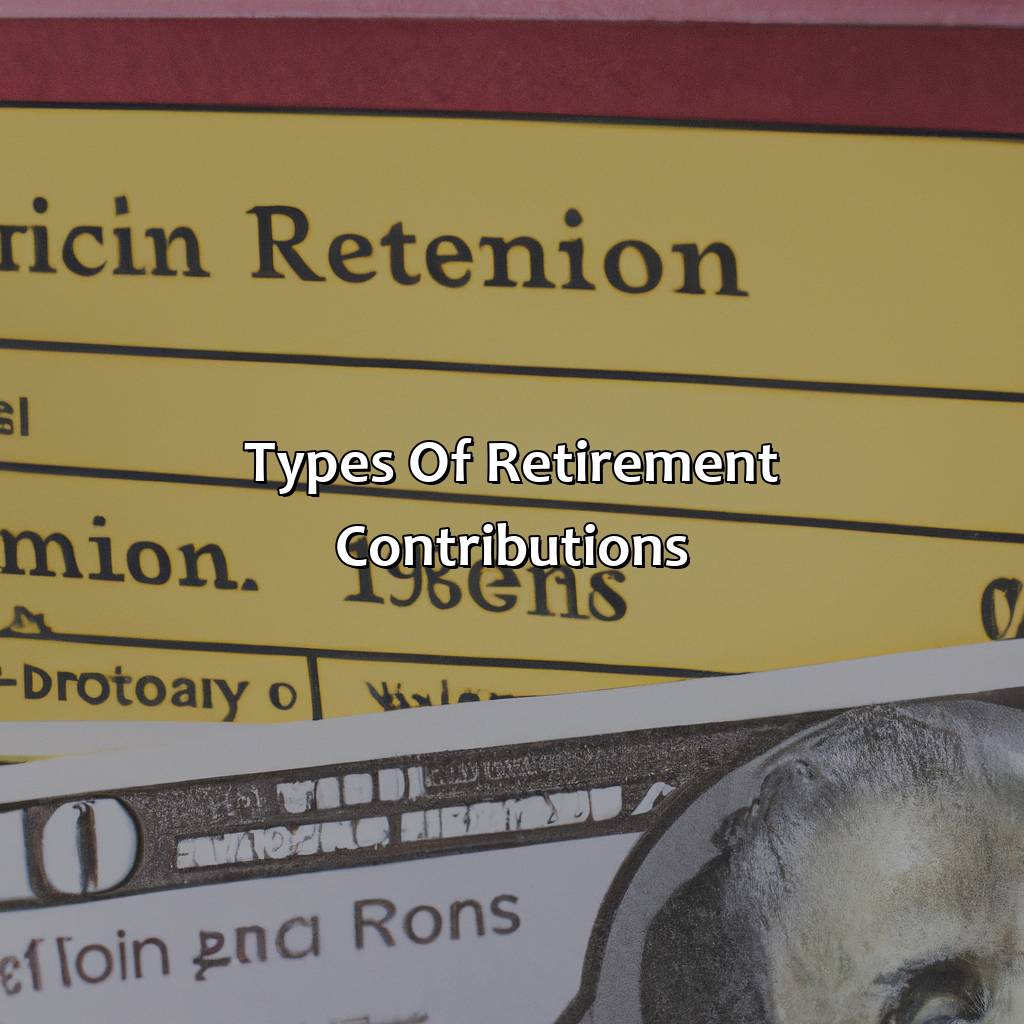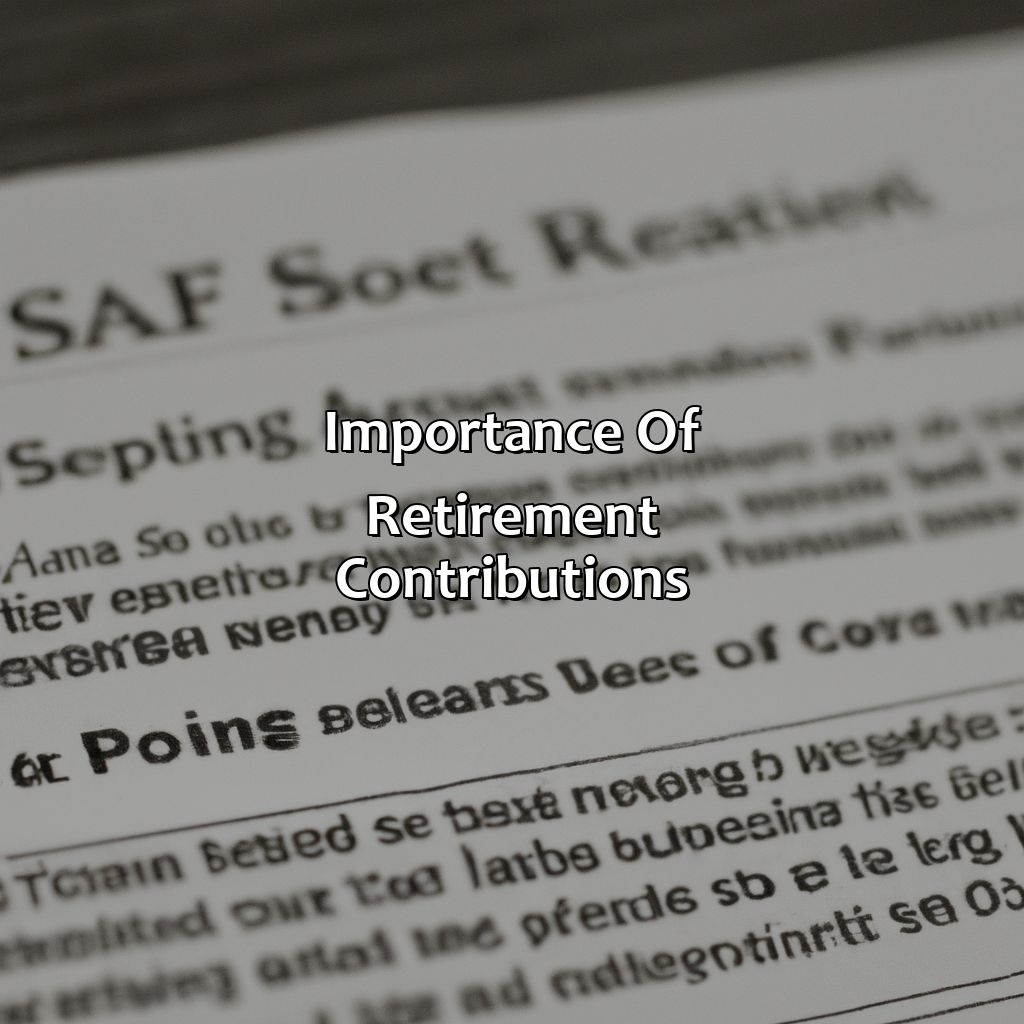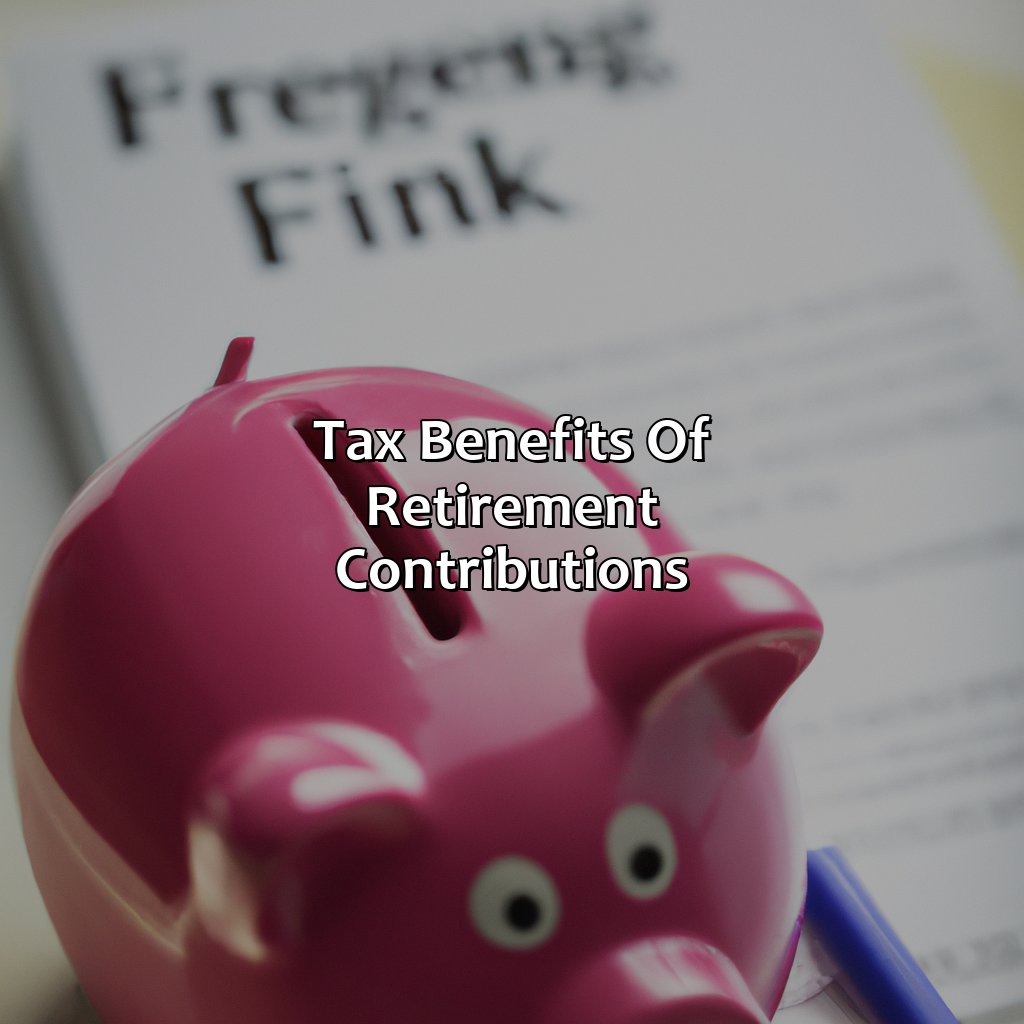What Is Retirement Contribution?
Key Takeaway:
- Retirement contribution refers to the amount of money an individual sets aside during their working years to ensure they have a comfortable income in retirement.
- There are different types of retirement contributions including employer contributions, employee contributions, and catch-up contributions which allow individuals to contribute more if they are over 50 years old.
- Retirement plan options include 401(k) plans, IRA (Individual Retirement Account), and pension plans which offer different advantages and disadvantages depending on an individual’s needs and circumstances.
- It is important to make retirement contributions to secure a comfortable financial future in retirement and avoid relying solely on social security benefits.
- Tax benefits of retirement contributions are another incentive to save for retirement, as contributions made towards retirement plans may be tax-deductible, reducing an individual’s taxable income.
Are you feeling overwhelmed when it comes to planning for retirement? Understanding retirement contributions can make the process less intimidating. You can make informed decisions about your financial future with knowledge of what contributes to retirement savings.
Definition of Retirement Contribution
Retirement contribution refers to the amount of money an employee saves for retirement, which is deducted from their paycheck and invested in a retirement savings plan, such as a 401(k) or IRA. The purpose of retirement contributions is to accumulate retirement savings, taking advantage of tax benefits offered by the government. Contributions may be made by both the employer and employee, with the investment gains being tax-deferred until they are withdrawn at retirement. Retirement contributions allow individuals to secure a stable financial future after they have retired, enabling them to live without financial worries and spend their time enjoying life.
To maximize retirement savings, employees must understand the contribution limit set by the government and the benefits of contributing more. For instance, in the United States, the contribution limit for 401(k) plans is $19,500 for individuals aged below 50, while those aged 50 and above can contribute $26,000. Additionally, employer matching contributions may help increase the amount individuals save for retirement.
It is important to start contributing to retirement savings early, as investing smaller amounts over a longer period of time leads to more significant gains in savings, thanks to compound interest. Furthermore, retirement contributions should be adjusted to keep in line with increases in salary or inflation.
A common mistake individuals make is not contributing enough to their retirement savings plan, which could hinder their ability to retire as planned. A story that illustrates this is that of John, who believed he was contributing enough to his 401(k) plan, but after closer examination, he realized that he needed to contribute more to ensure sufficient retirement savings. He increased his contribution and was able to meet his retirement savings goals.

Image credits: retiregenz.com by David Duncun
Types of Retirement Contributions
Understand how to help your retirement savings grow! We will explore the different types of contributions. These include employer contributions, employee contributions, and catch-up contributions. Each one offers its own solution to secure your retirement. Take the time to decide which option is best for you and your financial goals.

Image credits: retiregenz.com by Joel Woodhock
Employer Contributions
A crucial component of planning for retirement is to understand the various types of contributions available. One such type is the compensation paid by your employer, which is commonly known as Employment Contributions.
These contributions are provided by your employer on top of your salary and may take different forms such as matching contributions, profit-sharing contributions or non-elective or discretionary contributions. Matching Contributions entail an employer contribution that matches what an employee contributes to the retirement plan. Profit-sharing Contributions are based on the company’s profits and distributed accordingly among its employees. Non-Elective or Discretionary Contributions do not require employee participation but can be given at an employer’s discretion.
Apart from the benefits of enhancing one’s retirement savings, Employment Contributions can also reduce an individual’s taxable income. As these financial incentives encourage employees to participate in their employers’ retirement plan scheme, it enables a better future financially.
Therefore, individuals should take this into account when deciding on their employment options and consider companies that offer generous Employment Contribution plans for a well-prepared retirement fund.
Don’t worry about retiring broke, just put all your faith in the power of wishful thinking and lottery tickets – employee contributions are totally optional!
Employee Contributions
The following are the types of employee contributions towards retirement:
- Voluntary Employee Contributions: this type of contribution allows employees to transfer portions of their salary into the retirement plan without requiring an employer match.
- Elective Deferral Contributions: this contribution method enables employees to defer some portion of their pre-tax salary into a qualified retirement plan, such as a 401(k) plan.
- Roth Contributions: Roth contributions are post-tax deductions made to the employee’s retirement plan. Taxation is paid upfront on these contributions, and they grow tax-free until the employee withdraws them in retirement.
Contributing towards your Future Self’s financial security with Employee Contributions contributes significantly to one’s peace of mind during post-retirement years.
It would be wise for employees to regularly assess the amount contributed towards retirement, aiming to maximize it every year. This can be achieved by consulting with a financial advisor or utilizing online tools like calculators or mobile apps. Maintaining documentation on all Retirement account transactions can significantly aid ease in monitoring progress and planning adjustments.
For those of us who didn’t start saving for retirement until our mid-life crisis hit, catch-up contributions are like a mid-life CPR.
Catch-Up Contributions
For individuals past 50, additional retirement contributions can be made, known as Enhanced Contributions. Here are six key points regarding these contributions:
- Enhanced Contributions are available to those who will turn fifty or older before the end of the year for which they wish to make the contribution.
- These can only be made to qualified employer-sponsored plans or Self-Employment Retirement plans (SEPs) and Simple IRA accounts and must follow plan requirements.
- The maximum amount allowed as an enhanced contribution is determined by the plan. Currently, $6,500 is allowed in a 401(k) plan; A Simple IRA allows up to $3,000 as an enhanced contribution.
- You may make enhanced contributions even if you contribute other dollars to your qualified retirement plan account throughout the year. However, there are limits on what you could add overall – including all contributions – in a tax year, both conventional and improved combined.
- An enhanced contribution is designed for people who did not contribute enough earlier. Individuals with high incomes can decrease tax liability by contributing more funds in their accounts than regular allowables permit.
- The availability of improved contributions has to consider several factors such as: benefit base income levels (if applicable), Internal Revenue Code Section 415 limitations (pertaining to defined benefits plans), prohibited transactions and ERISA law compliance among others.
Enhanced Contributions provide some flexibility when planning for retirement during those later years. Additionally, employers often match up to a certain percentage of employee contributions into their accounts. If possible, take advantage of this opportunity for increased financial security in your later years by making catch-up contributions today!
Retirement plan options: because who doesn’t love the thrill of choosing between a 401(k) and an IRA?
Retirement Plan Options
Retirement plans have a few options. Check out 401(k)s, IRAs, and pensions. Each one offers distinct ways to plan for retirement contributions. Dig into them and find the perfect plan for you!

Image credits: retiregenz.com by James Woodhock
401(k) Plans
Employer-sponsored Defined Contribution Retirement Plans
Defined contribution retirement plans sponsored by employers, such as 401(k)s, are popular and essential in the modern workforce. Here are five crucial points to understand about these retirement plans:
- Employees contribute pre-tax earnings into individual accounts
- Contributions can be matched by employers
- Funds grow tax-free until withdrawn during retirement
- Withdrawals before the age of 59 and a half incur taxes and penalties
- Options for investments may include stocks, bonds, mutual funds, or target-date funds.
In addition to the above, contribution limits and vesting periods vary by plan type. It is therefore important to analyze potential employer plan options to maximize contributions for future financial security.
It is worth noting that many employers offer both defined benefit plans (pensions) and defined contribution plans (401(k)s). Research shows that less than a third of middle-income workers receive pension benefits from their current jobs as many companies have transitioned towards defined contribution plan offerings.
According to Fidelity Investments, “workers who save consistently in both their workplace savings plan [such as a 401(k)] and an IRA over their careers could potentially achieve at least eight times their ending salary in savings.”
Saving for retirement is like playing a game of chess, but with an IRA, you get to be the queen – always anticipating and making strategic moves.
IRA (Individual Retirement Account)
Individual Retirement Accounts (IRA) are a type of retirement savings account that provides tax benefits to the account holder. Contributions made to an IRA can be deducted from your taxable income, and the earnings on those contributions grow tax-free until you withdraw the money during retirement.
IRAs come in two main types – Traditional IRA and Roth IRA. Traditional IRAs allow for tax-deductible contributions, whereas Roth IRAs utilize after-tax dollars. Additionally, Roth IRAs offer tax-free withdrawals in retirement while Traditional IRAs are taxed at the time of withdrawal.
It is important to note that there are eligibility requirements for contributing to either type of IRA and contribution limits that vary depending on age and other factors. It is important to consult with a financial advisor or tax professional to determine which type of IRA is right for your retirement plan.
Don’t miss out on maximizing your retirement plan options by considering opening an IRA. Start planning early to ensure a comfortable retirement!
Who needs a fancy vacation when you can retire and live off your pension plan? #LivingTheDream
Pension Plans
Retirement Benefits – Invest in Your Future
Planning your retirement can be overwhelming, but with a range of retirement benefits, you can secure your future. Retirement plans are significant investment tools that assist you in saving for a better and comfortable post-retirement life. These savings ensure your financial independence and help you lead a stress-free retired life.
You can opt for several pension plans varying from employer-sponsored to individual retirement accounts (IRAs), which suit different individuals’ needs. Pensions offer tax-efficient ways of growing wealth while contributing extra or as an alternative to company pension schemes.
Furthermore, pension arrangements allow flexible investment choices while assuring the benefit stipulated at the end of your term. Understanding your options could help simplify decision-making when exploring lifelong investment choices.
Start investing today; don’t delay planning for tomorrow’s well-being. Avoid retiring with insufficient assets by making the right investments now!
Retirement contributions may not be as fun as a yacht party, but they sure can prevent future financial shipwrecks.
Importance of Retirement Contributions
Retirement Contributions are crucial for securing financial stability in old age. Contributions can be made through various investment channels, such as 401(k) or IRA plans. An adequate contribution ensures a comfortable lifestyle in retirement, reduces dependency on social security, and enables one to achieve financial goals.
Moreover, Retirement Contributions are flexible, and early contributions yield higher returns than those made later in life. In addition, higher contributions provide tax benefits, and employers might match contributions. Therefore, it is vital to start making Retirement Contributions early and with a substantial amount. By doing so, one can enjoy a comfortable retirement without worrying about finances.

Image credits: retiregenz.com by Adam Washington
Tax Benefits of Retirement Contributions
Maximizing Retirement Savings with Tax Benefits
Retirement contributions have significant tax benefits that can be helpful for anyone looking to save for their future. These benefits can help reduce taxable income, increase retirement savings, and potentially lead to increased returns in the long term.
Here are the top 5 tax benefits of contributing to retirement plans:
- Contributions to retirement accounts are tax-deductible, which means that the amount contributed can be deducted from your taxable income.
- Earnings on retirement savings are tax-deferred, meaning you won’t pay taxes on the money earned until withdraw in retirement.
- Retirement savings can grow tax-free, which means you won’t have to pay taxes on any interest, dividends, or capital gains.
- Contributions to Roth IRA retirement accounts are made with after-tax dollars; however, earnings are tax-free.
- Some retirement plans, such as the Roth IRA, do not have required minimum distributions (RMDs), which means you can leave your savings to grow for as long as you want.
It is imperative to note that tax laws regarding retirement contributions are not static and may change depending on the current legislative environment. Thus, it is essential to stay informed about the latest developments regarding retirement contribution policies and adjust your strategies accordingly to maximize benefits.
To enhance your tax benefits while contributing to retirement plans, consider the following suggestions:
- Consider your company’s 401(k) matching policy and contribute the maximum amount to qualify for the employer match.
- Research and consult a financial advisor to find out which retirement plan is best suited for your financial goals and individual circumstances.
- Regularly adjust your retirement contributions to meet your evolving needs and maximize tax efficiency.
By following these suggestions, you can minimize your tax liability and maximize your retirement savings.

Image credits: retiregenz.com by Harry Jones
Some Facts About Retirement Contribution:
Retirement contribution refers to the money you save towards your retirement. (Source: NerdWallet)
Many employers offer retirement contribution plans, such as 401(k) or pension plans, to help their employees save for retirement. (Source: The Balance)
Retirement contribution plans often come with tax benefits, allowing you to save on taxes while you save for retirement. (Source: IRS)
The maximum amount you can contribute to your retirement plan each year is determined by the IRS and varies based on your age and type of plan. (Source: Kiplinger)
Starting to save for retirement early can make a big difference in how much you have saved by the time you retire. (Source: CNBC)
FAQs about What Is Retirement Contribution?
What is retirement contribution?
Retirement contribution is the amount of money an individual puts in a retirement savings account, such as a 401(k) or IRA, to save for their future retirement. These contributions are typically made on a pre-tax basis and may be matched by an employer.
How much should I contribute to my retirement account?
There is no one-size-fits-all answer to this question, as it depends on several factors such as your age, income, and retirement goals. As a general rule, financial experts recommend contributing at least 10-15% of your income to your retirement account.
What are the benefits of making retirement contributions?
Making retirement contributions allows you to save for your future retirement and take advantage of tax benefits. Depending on the type of retirement account you have, your contributions may be tax-deductible or grow tax-free until you withdraw them in retirement.
What is the difference between a traditional and a Roth retirement account?
With a traditional retirement account, contributions are made on a pre-tax basis and are taxed upon withdrawal in retirement. With a Roth retirement account, contributions are made on an after-tax basis and are not taxed upon withdrawal in retirement.
What happens if I withdraw my retirement contributions early?
If you withdraw your retirement contributions before age 59 1/2, you may be subject to both taxes and a 10% penalty on the amount withdrawn. There are some exceptions to this rule, such as using the funds for certain medical expenses or as a first-time homebuyer.
Can I contribute to a retirement account if I am self-employed?
Yes, self-employed individuals have several retirement savings options available to them, including solo 401(k)s and simplified employee pension (SEP) plans. These retirement accounts offer similar tax benefits and contribution limits as traditional 401(k)s and IRAs.
 Checkout this IRS Loophole
Checkout this IRS Loophole 






